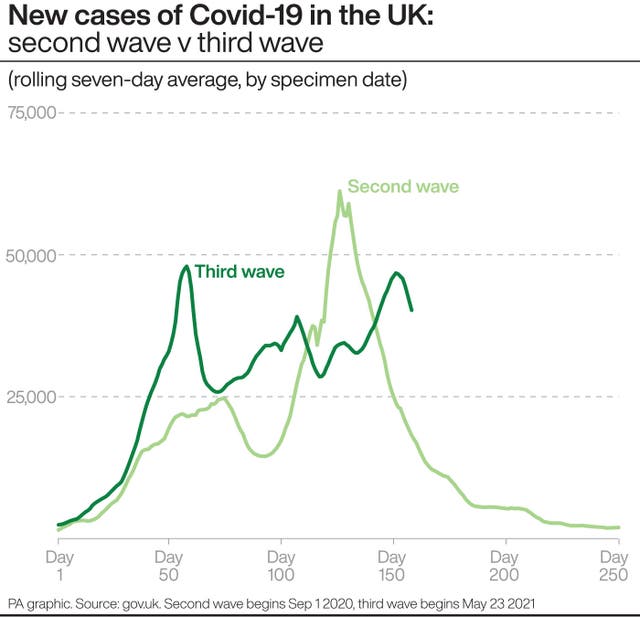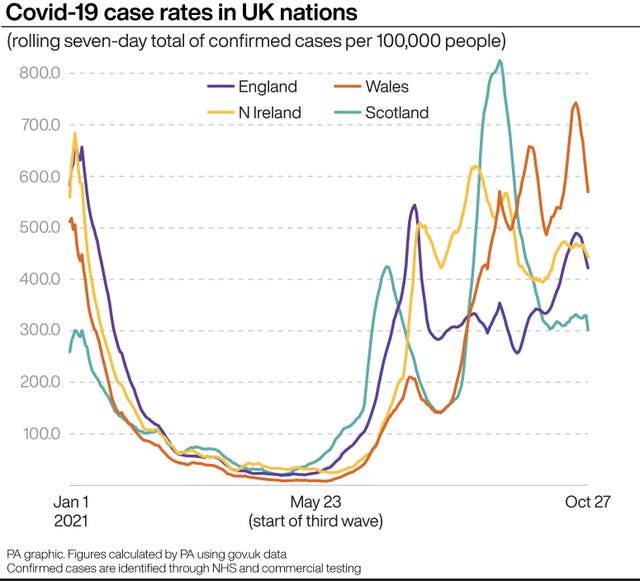Where in the UK are Covid-19 case rates still rising?
Parts of Leicestershire, Kent and West Sussex are currently seeing a jump in rates.

Covid-19 case rates are continuing to rise in nearly one in five local areas in the UK, with sharp increases recorded in the East Midlands, latest figures show.
Rates in most areas are now falling, however, with national rates also on a downward trend, suggesting the third wave of the virus is now being driven by localised outbreaks rather than a country-wide surge in new cases.
A total of 66 of the 377 local authority areas in the UK (18%) recorded a week-on-week rise in rates in the seven days to October 27, while 311 (82%) saw a fall, according to PA news agency analysis of Government data.

South-west England continues to have the highest rates of any part of the UK, but they are now falling in 26 of the 29 local authorities in the region.
In Tewkesbury in Gloucestershire, the rate is down from 1,228.5 cases per 100,000 people to 846.6, while neighbouring Stroud has seen its rate fall from 1,230.7 to 818.0.
Rates are also dropping in nearly all areas of eastern England, London, north-west England and the West Midlands, while every area in Wales is currently recording a week-on-week fall.
By contrast, of the 10 local areas with the biggest week-on-week increase in rates, five are in Leicestershire: Blaby (up from 363.9 to 496.3), Leicester (312.7 to 415.2), Charnwood (341.3 to 432.6), Hinckley & Bosworth (482.1 to 569.2) and Harborough (390.4 to 476.3).
Nearby Rutland has also recorded an increase (from 392.8 to 471.9), as have other areas in the East Midlands including South Holland in Lincolnshire (416.2 to 472.6) and Nottingham (253.9 to 304.4).
This pattern is not the same for the whole of the region, however, with all areas in Derbyshire and Northamptonshire recording a fall.
There is a similarly mixed picture in other regions, such as south-east England, where parts of Kent and West Sussex are currently seeing a rise in rates but all areas of Hampshire and Berkshire are falling.

The data suggests a shift in the third wave of coronavirus, from a broad rise in new cases across most of the country to increases that are limited to pockets of areas.
It is too soon to say if this shift has been caused by specific events or changes in behaviour, such as the recent school half-term holiday or the rollout of Covid-19 vaccine booster doses.
The Orkney Islands in Scotland have seen the biggest week-on-week increase in rates in the latest figures, up from 227.7 cases per 100,000 to 366.1 – though because of the small population size, this is the equivalent of 82 new cases, up from 51.
In 10 of the 32 local authorities in Scotland rates have increased, along with three of the 11 authorities in Northern Ireland.
Rates remains at a relatively high level across the UK, with only one area (the Shetland Islands) currently below 100 cases per 100,000 people.
But with a majority of local authority areas seeing a fall in new cases in the latest figures, all four nations are now showing a clear downwards trend in rates for the first time in several weeks.
England’s rate stood at 422.1 as of October 27, down week-on-week from 489.8.
In Scotland the rate is 301.4, down from 332.0; Wales is down from 742.5 to 570.1; and Northern Ireland has fallen from 470.0 to 442.7.





